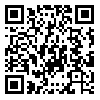Alireza Rezaei Alishahdani1 
 , Alireza Jafari Rad1
, Alireza Jafari Rad1 
 , Zahra Alaminia *2
, Zahra Alaminia *2 
 , Mehran Arian1
, Mehran Arian1 
 , Hemayat Jamali3
, Hemayat Jamali3 


 , Alireza Jafari Rad1
, Alireza Jafari Rad1 
 , Zahra Alaminia *2
, Zahra Alaminia *2 
 , Mehran Arian1
, Mehran Arian1 
 , Hemayat Jamali3
, Hemayat Jamali3 

1- Islamic Azad University
2- Ferdowsi University of Mashhad ,alaminia@um.ac.ir
3- University of Isfahan
2- Ferdowsi University of Mashhad ,
3- University of Isfahan
Abstract: (343 Views)
The Shourab prospect, located in the west of Central Iran, exhibits significant hydrothermal alteration and trace element anomalies linked to potential Iron Oxide Copper-Gold systems (IOCG) mineralization. Alteration zones are characterized by chlorite, calcite, quartz, biotite, K-feldspar, albite, actinolite, sericite, and tourmaline, with variable intensities across mafic to felsic volcanic units. Molar element ratio (MER) and alteration indices (AI and CCPI) were employed to quantify alteration processes, revealing progressive alteration from peripheral propylitic zones to core potassic and sodic-calcic assemblages. Spatial geochemical anomalies of elements such as Au, Cu, U, Mo, Ba, Sm, Ce, and La strongly correlate with specific alteration zones. Mineralogical evidence and statistical analysis of lithogeochemical indices such as iron, potassium, and rare earth element enrichment along with hydrothermal alteration indices, indicate a genetic similarity between this magmatic-hydrothermal system and IOCG type systems. Host rock composition, fluid-rock interaction, and structural controls significantly influenced alteration styles. This work provides a comprehensive framework for identifying hydrothermal footprints of IOCG mineralization in complex volcanic-intrusive terrains and contributes to future exploration strategies in the west Central Iran.
Type of Study: Original Research |
Subject:
Economic Geology
Received: 2025/08/4 | Accepted: 2025/09/24
Received: 2025/08/4 | Accepted: 2025/09/24
Send email to the article author
| Rights and permissions | |
 |
This work is licensed under a Creative Commons Attribution-NonCommercial 4.0 International License. |




